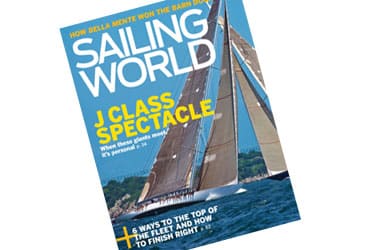
Sailing World: October 2011
Rambler 100 is the most state-of-the-art monohull on the water today. That’s the same Rambler 1_00 that shaved the Caribbean 600 race record, and then, this past summer beat the Transatlantic Race record, too. It’s the same _Rambler 100 that found itself upside down after its keel snapped off during the Rolex Fastnet Race in August.
The boat didn’t hit anything as far as we know. The keel and bulb just snapped off and sank to the bottom of the Irish Sea. Maybe the fin wasn’t engineered strong enough, or there was a flaw in the material. We may never find out, but, regardless, when it failed, the crew went from race mode to survival mode in 30 harrowing seconds. The outcome could’ve been bad—really bad, which is why the incident hits home. Rambler‘s capsize was a terrifying experience for the people on board, and it was a major wake up call for me. Why? Because I race offshore for a living, and I’m about to start an around-the-world race on a canting-keel boat a lot like Rambler 100.
There were five people inside the boat when it went turtle; three were nearly trapped. On deck, five of the crew were washed clear of the boat, couldn’t get back, and were in the water for nearly three hours. It was an unforgettable experience by all accounts, but because of the seamanship and experience of those involved, the story has a happy ending and a few lessons that we can all take to sea. I know I will.
Have your lifejacket in reach at all times. The boat’s project manager, Mick Harvey, was in his bunk at the time of the capsize. He had on his boots and foul weather gear pants, but he wasn’t wearing a jacket or lifejacket. He immediately knew the keel had snapped; he said it was the sound of a cannon shot. When he jumped from his bunk, the mast was already in the water. His lifejacket was 20 feet to leeward, hanging on his hook. He decided to leave the lifejacket and get out before the boat turned turtle. He thought he made the right call at the time, but almost drowned because his pants filled with water as he swam out from beneath the hull. If it weren’t for Jerry Kirby and Jan Dekker, who pulled him to the surface, he probably would have drowned.
What we learn here is that when you’re in your bunk, in heavy conditions, keep your lifejacket and gear within arm’s reach. Without a lifejacket your likelihood of survival is substantially reduced. If you have hooks or cubbies for individual lifejackets and harnesses on your boat, think about how accessible they’d be in the most extreme circumstances.
**To auto inflate or not? **The crew that became trapped inside and had to get out from beneath it once the boat turned turtle had a tough time getting out. They had to dive down and get through or below lifelines. None of them would’ve been able to do this had their lifejackets been set to automatically inflate. I’ve disarmed the auto-inflate feature on my lifejacket, and so too has everyone else on my PUMA Ocean Racing team. The Rambler crew was lucky they did, too. If any of them had their auto-inflate on, they would have been trapped or pinned under the boat with no way to get out. What if you’re knocked unconscious and go overboard with the auto-inflate feature disabled? The likelihood of survival isn’t good if you’re unconscious anyway. I’d rather have the ability to swim out from under something, and considering what happened with Rambler, I’ll definitely keep my auto-inflate disarmed.
A harness is only half the safety. A lot of people wear only harnesses without flotation, reasoning the key is to stay with the boat. But what happens if you get separated, as did five of Rambler‘s crew? Webbing harnesses wouldn’t have been much good in this scenario. Modern inflatable lifejacket/harness combinations are comfortable and fit like vests. They’re far better than a harness alone. The fact that the safety rules for the Fastnet Race mandate lifejackets worn when reefed, when winds are over 25 knots, and at night, saved a bunch of lives.
You must be able to grab your grab bags. When Rambler capsized, I’m told, there was no way to get to the grab bags or survival suit bag. Why not? Nobody could find them. It was pitch black inside the boat, and there was no time. If the guys had retrieved the grab bag they would’ve been rescued hours earlier. On the Volvo Ocean Race boats, by rule, we have to store our grab bags in lockers with plastic locks on them to keep them secure. We always know where they are, but on the other hand, they’re locked and we need a knife to open them. I’d be sure to keep at least one grab bag near the companionway. In it should be an EPIRB, flares, medical equipment, and a satellite phone.









